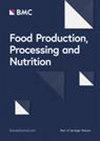藜麦(Chenopodium quinoa野生)和虎坚果(Cyperus esculentus L.)有机加糖无麸质早餐的营养、理化和质量概况
IF 5.7
3区 农林科学
Q2 FOOD SCIENCE & TECHNOLOGY
引用次数: 0
摘要
摘要:本研究以藜麦和虎坚果为原料,通过有机增甜的方式制作早餐,旨在协同利用这两种食物中的天然生物活性化合物。与商业样品相比,所有配方的蛋白质和脂肪含量都较高。这些食物含有很少的淀粉,最重要的是,超过35%的淀粉是不可消化的。膳食中主要矿物质为钾(481.81 ~ 592.47 mg/100 g)、磷(231.75 ~ 257.20 mg/100 g)、镁(152.34 ~ 176.29 mg/100 g)、钙(257.45 ~ 266.61 mg/100 g), Na/K摩尔比<1.0对高血压患者有利。在不同测定法(FRAP、ABTS和DPPH)中,总酚和类黄酮含量优于商业产品,具有显著的抗氧化能力。对碳水化合物水解酶的抑制能力明显高于商品食品。无论藜麦和虎坚果的添加量如何,对α-淀粉酶的抑制效果均较好(α-淀粉酶26.98 ~ 60.18%;α -葡萄糖苷酶19.47-40.02%)。同样,这些食物的化学性质受其高蛋白、脂肪、膳食纤维和低糖的影响,以一种独特的方式调节了其功能特性。在感官评估方面,小组成员将所有考虑到的感官参数与商业食品相似,有时甚至高于商业食品。从藜麦-虎坚果混合物中提取甜菊糖早餐的生产、营养和功能特征的图形表示本文章由计算机程序翻译,如有差异,请以英文原文为准。
Nutritional, physicochemical and quality profiles of organically sweetened gluten-free breakfast meal from quinoa (Chenopodium quinoa Willd) and tigernuts (Cyperus esculentus L.)
Abstract By formulating a breakfast meal from quinoa and tigernuts that is organically sweetened, this study aimed to synergistically utilize the natural bioactive compounds embedded in both foods. When compared to commercial sample, all formulations had higher protein and fat contents. The meals contained little starch, and most significantly, over 35% of this starch was non-digestible. The main minerals found in the meals were potassium (481.81—592.47 mg/100 g), phosphorus (231.75—257.20 mg/100 g), magnesium (152.34—176.29 mg/100 g), and calcium (257.45—266.61 mg/100 g, with the Na/K molar ratio < 1.0 advantageous for those with high blood pressure. Regarding overall phenol and flavonoid contents, the meals outperformed the commercial product with remarkable antioxidant capacities when tested against different assays (FRAP, ABTS, and DPPH). The meals' inhibitory capacities on both carbohydrate-hydrolyzing enzymes were noticeably higher than that of the commercial product. Regardless of the amount of quinoa or tigernuts in each blend, the inhibitory performance was satisfactory (α-amylase 26.98—60.18%; α -glucosidase 19.47—40.02%). Similarly, the chemical properties of the meals as influenced by its higher protein, fats, dietary fibre, and low sugar, modulated its functional properties in a unique way. In terms of sensory assessment, the panelists ranked the meals similar and sometimes above the commercial ones with respect to all the organoleptic parameters considered. Graphical Abstract A graphical representation of production, nutritional and functional characterization of stevia-sweetened breakfast meals from quinoa-tigernuts blends
求助全文
通过发布文献求助,成功后即可免费获取论文全文。
去求助
来源期刊

Food Production, Processing and Nutrition
Medicine-Public Health, Environmental and Occupational Health
CiteScore
6.90
自引率
4.30%
发文量
28
审稿时长
12 weeks
 求助内容:
求助内容: 应助结果提醒方式:
应助结果提醒方式:


